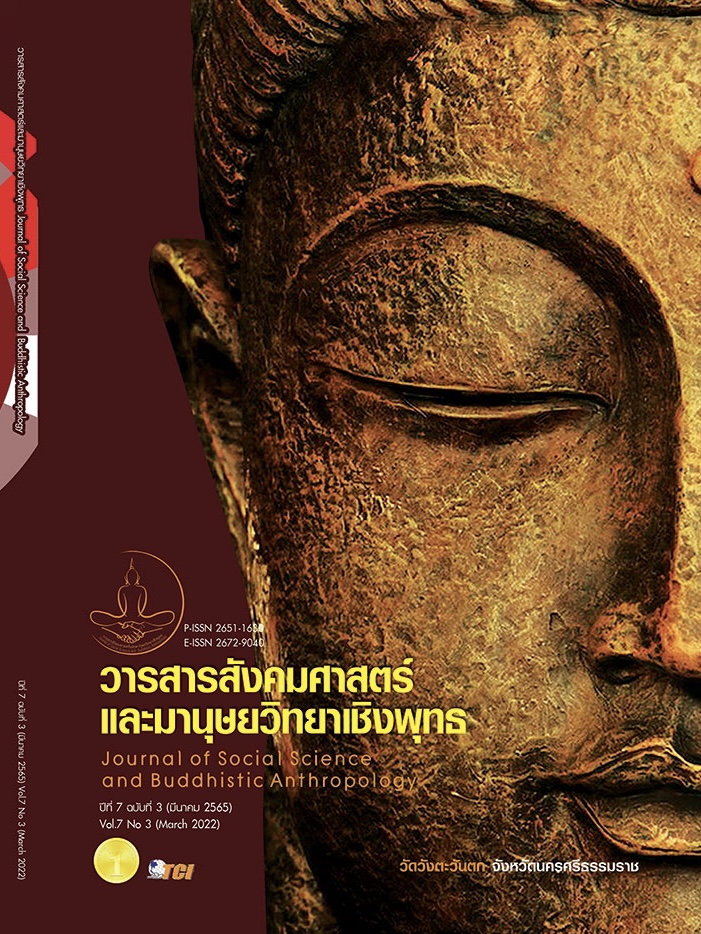MARKETING STRATEGIES OF PRIVATE NURSING HOME IN THAILAND
Keywords:
Marketing Strategy Model, Private Nursing Home, Older PersonAbstract
The objectives of this research article were to 1) analyze the components of external and internal environmental factors, service marketing factors and the achievement of the private nursing home in Thailand 2) analyze the influences of external and internal environmental factors, service marketing factors towards the achievement of the private nursing home in Thailand, and 3) present strategic marketing model of the private nursing home in Thailand. It was mixed-method research. The population was the purchasers of the service, or an older person, age ranging from 60 to 80 years who had been using the service for at least one month in private nursing homes during February to March 2020 in 73 locations across the country registered with the Department of Business Development, Ministry of Commerce 2017. The 422 samples were selected according to the sizes of the nursing home as follows: three of small size, 56 of medium size and 14 of large size establishments. The questionnaire was used as a research tool. Data were analyzed using descriptive statistics and structural equation model analysis. The qualitative research was done using an in-depth interview form to interview 10 executives from high-performance achievement private nursing homes. The content was analyzed to assess the strategy used in administration. The results of the research revealed the marketing strategy of the private nursing homes in Thailand consisted of external influencing factors which private nursing homes should give importance to economic conditions; internal influence factor which they should give importance to building users’ motivations, affecting their decisions to use the service; marketing factor which they should give importance to a channel of distribution strategy; and the achievement of the private nursing home which they should give importance to quality criteria and marketplace criteria. The importance should be given as the establishments used them as their main techniques for evaluating the achievement of the private nursing home business in Thailand.
References
กรมกิจการผู้สูงอายุ. (2560). โครงการการศึกษารูปแบบการให้บริการการบริหารและการจัดการที่พักสำหรับผู้สูงอายุ. เรียกใช้เมื่อ 7 ธันวาคม 2563 จาก http://www.dop. go.th/th/know/4/109
กรมพัฒนาธุรกิจการค้า. (2563). บทวิเคราะห์ธุรกิจ. เรียกใช้เมื่อ 14 ธันวาคม 2563 จาก https://www.dbd.go.th/download/document_file/Statisic/2563/T26/T26_202003.pdf
มูลนิธิสถาบันวิจัยและพัฒนาผู้สูงอายุไทย. (2563). สถานการณ์ผู้สูงอายุไทย พ.ศ. 2562 “SITUATION OF THE THAI ELDERLY 2019”. เรียกใช้เมื่อ 15 ธันวาคม 2563 จาก https://thaitgri.org/?p=39387
วัชรากรณ์ ชีวโศภิษฐ. (2562). สังคมผู้สูงอายุ: ปัจจัยการตลาดที่เปลี่ยนไป. วารสารมหาจุฬานาครทรรศน์, 6(2), 38-54.
ศูนย์วิจัยกสิกรไทย. (2560). การลงทุนในอุตสาหกรรมเป้าหมายในระเบียงเศรษฐกิจภาคตะวันออก (ECC) อุตสาหกรรมการท่องเที่ยวเชิงคุณภาพและสุขภาพ (กระแสทรรศน์ ฉบับที่ 2832). เรียกใช้เมื่อ 22 มีนาคม 2560 จาก https://kasikornresearch.com/th/analysis/k-econ/economy/Pages/36215.aspx
ศูนย์วิจัยกสิกรไทย. (2561). ธุรกิจศูนย์ดูแลผู้สูงอายุในไทย. เรียกใช้เมื่อ 15 มกราคม 2562 จาก https://kasikornbank.com/international-business/th/Thailand/IndustryBusiness/Documents/201811_Thailand_Elderly_TH.pdf
Ahmad, K. & Mohammad, A. (2007). The Impact of Competitive Environment: On the Service Marketing Mix Strategy of Health Organisations in Developing Countries: Jordanian Private Sector Hospital Senior Managers Perspective. In Doctoral thesis. University of Huddersfield.
Ala, E. et al. (2013). The Impact of Marketing Mix Strategy on Hospitals Performance Measured by Patient Satisfaction: An Empirical Investigation on Jeddah Private Sector Hospital Senior Managers Perspective. International Journal of Marketing Studies, 6(5), 210-227.
Castle, N. (2010). Challenges to Achieving Adequate Sample Sizes for Facility Level Evaluations of Nursing Home Resident Satisfaction. Ageing International, 35(1), 61-71.
Centers for Medicare & Medicaid Services. (2019). Five-Star Quality Rating System. Retrieved November 16, 2019, from https://www.cms.gov/Medicare/Provider-Enrollment-and-Certification/Certificationand Complianc/FSQRS
Durmaz, Y. (2014). The Impact of Psychological Factors on Consumer Buying Behavior and an Empirical Application in Turkey. Asian Social Science, 10(6), 194-204.
Elaine, M. (2020). Patient feedback: how effectively is it collected and used? Research Gate, 116(12), 27-29.
Gillian, E. et al. (2020). International and National Quality and Safety Indicators for Aged Care. Retrieved February 20, 2021, from https://agedcare.royalcommission.gov.au/sites/default/files/202008/research_paper_8_-_international_and_national_quality_and_safety_indicators_for_aged_care.pdf
Harrington, C. et al. (2021). Nursing Indicators of Quality in Nursing Homes. Retrieved May 29, 2021, from https://journals.healio.com/doi/10.3928/0098-9134-20031001-04
Hawkins, D. et al. (2001). Consumer Behavior: Building Marketing Strategy (8th Edition). Irwin: McGraw-Hill.
HealthWorks Collective. (2018). Digital Marketing Dominates Healthcare Advertising. Retrieved October 20, 2018, from https://www.healthworkscollective.com/author/responseminehealth/
Hendrik, S. & Magdalena, A. (2020). Determinants of nursing home choice: Does reported quality matter?: Determinants of nursing home choice. Health Economics, 29(3), 766-777.
Ibrahim, R. & Primiana, I. (2015). Influence Business Environment on the Organization Performance. International Journal of Scientific & Technology Research, 4(4), 283-293.
Kenneth, E. & Donald, B. (2012). Integrated Advertising, Promotion, and Marketing Communications (5th Edition). London: Pearson Education.
Kotler, P. et al. (2016). Marketing Management (3rd edition). Harlow: Pearson education.
Lovelock, C. & Wirtz, j. (2011). Principles of Service Marketing: People. In Technology, Strategy (7th ed). London: Pearson education.
Purcarea, V. (2019). The impact of marketing strategies in healthcare systems. Journal of Medicine and Life, 12(2), 93–96.
Rakesh, C. (2014). PEST Analysis for Micro Small Medium Enterprises sustainability. MSRU AS-JMC, 1(1), 18-22.
Sarah, R. et al. (2020). The relationship of nursing home price and quality of life. BMC Health Service Research, 20(2020), 1-10.
Sharan rs. (2015). 8'Ps for Services. Retrieved January 30, 2017, from https://prezi.com/f_a-hmagfjsv/8ps-for-services/
United Nations. (2020). World Population Ageing 2020 Highlights. Retrieved January 29, 2017, from https://www.un.org/development/desa/pd/sites/www.un.org.development.desa.pd/files/files/documents/2020/Sep/un_pop_2020_pf_ageing_10_key_messages.pdf
Downloads
Published
How to Cite
Issue
Section
License
Copyright (c) 2022 Journal of Social Science and Buddhistic Anthropology

This work is licensed under a Creative Commons Attribution-NonCommercial-NoDerivatives 4.0 International License.








